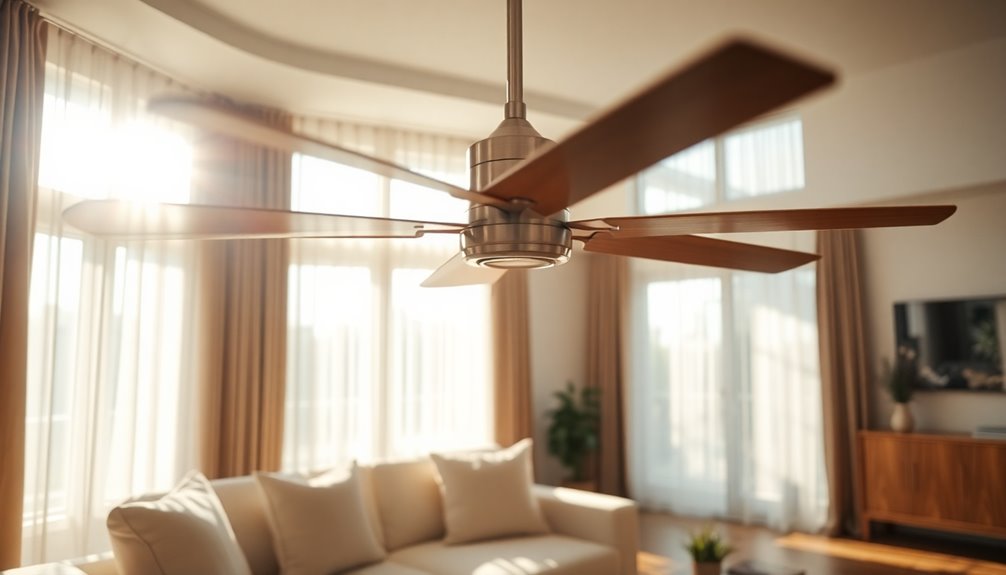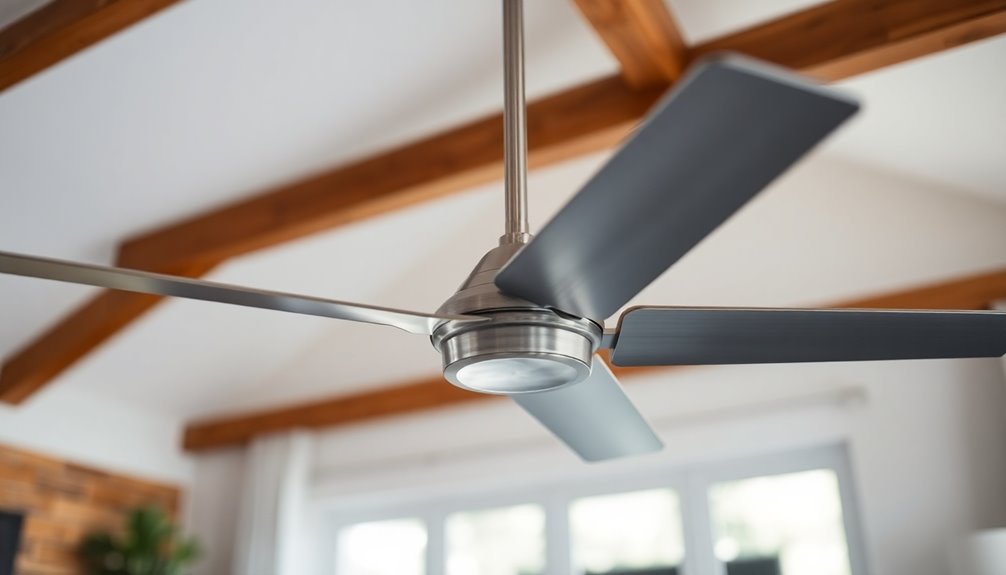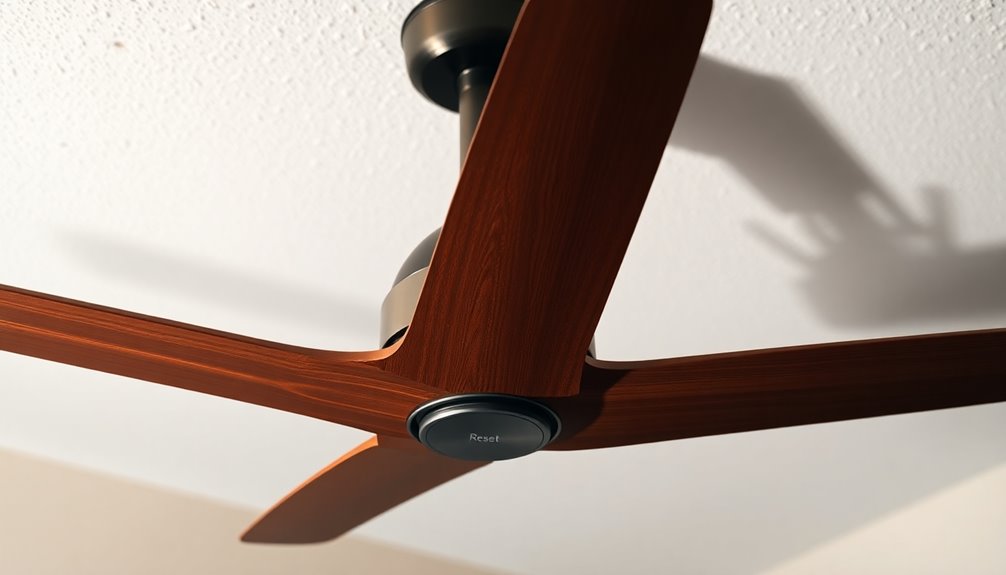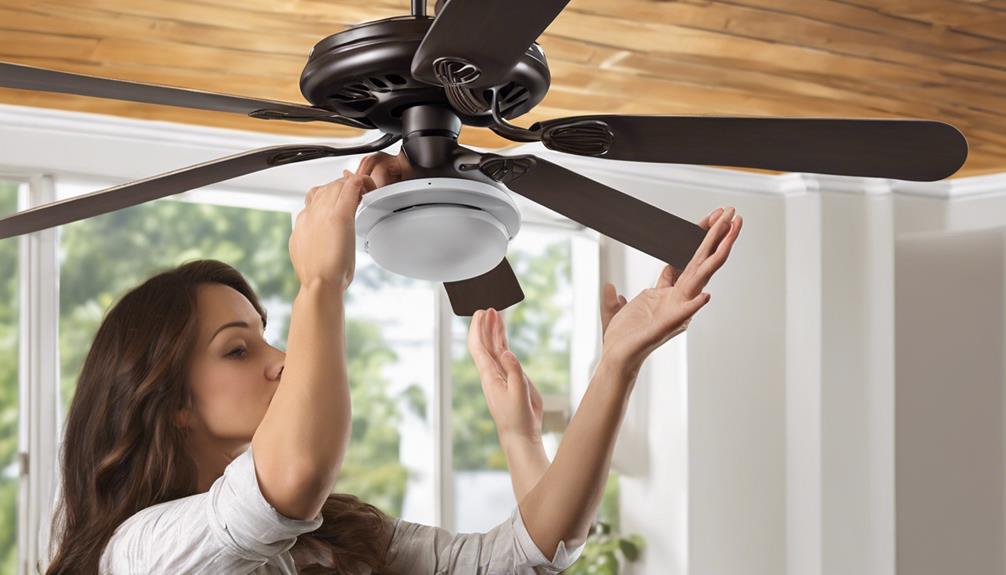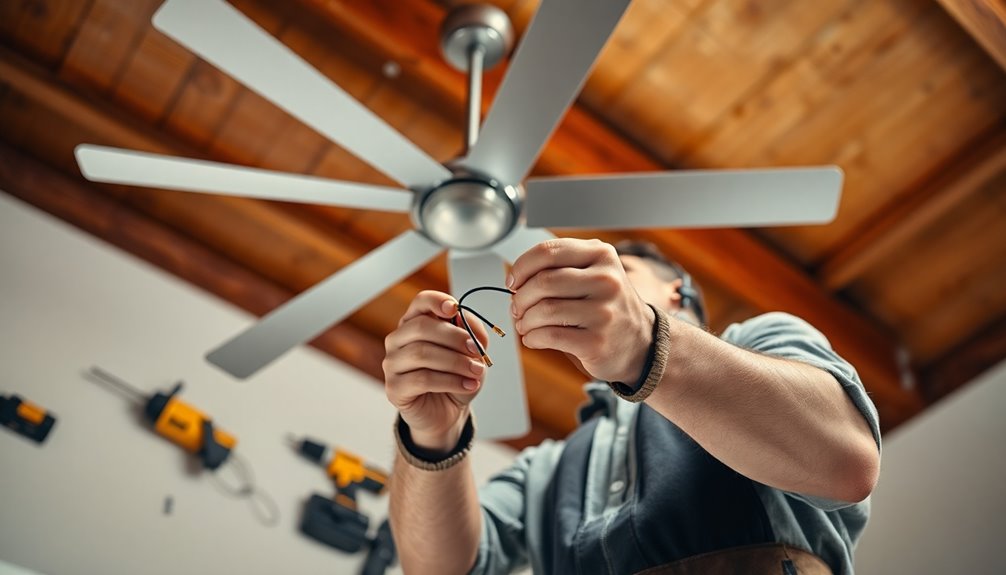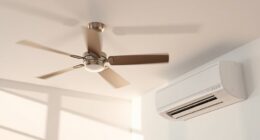Yes, reversing a ceiling fan does work and can greatly enhance your home's comfort during winter. When you switch the fan to clockwise, it pushes warm air down and redistributes it throughout the room, creating a cozy atmosphere. This simple adjustment can even help you save on heating costs by allowing you to lower your thermostat settings. Plus, using your fan effectively can lead to more efficient heating and a uniform temperature. It's a small change that brings noticeable benefits, and there's plenty more to discover about seasonal fan use and energy savings if you keep exploring.
Key Takeaways
- Reversing a ceiling fan changes blade rotation, enhancing air distribution and comfort in both summer and winter.
- In winter, clockwise rotation redistributes warm air, reducing heating costs by up to 10%.
- Counterclockwise rotation in summer creates a cooling breeze, improving comfort levels in warmer months.
- Regular adjustment of fan direction optimizes airflow and can lower thermostat settings by 3-5 degrees.
- Proper fan size is essential; choose fans based on room dimensions for effective air circulation and comfort.
Fan Rotation in Winter

When winter arrives, adjusting your ceiling fan's rotation can greatly improve your home's comfort. By setting the fan to rotate clockwise, you can push warm air down from the ceiling, creating an updraft that helps redistribute heat throughout the room. This simple change in fan rotation effectively eliminates temperature stratification, ensuring more uniform warmth without generating uncomfortable downdrafts.
You'll notice that operating the fan in this direction enhances thermal comfort, which is especially beneficial if you have high ceilings. In these spaces, warm air tends to collect near the ceiling, but reversing the fan's direction helps distribute that heat more evenly.
Running the fan on a low setting during winter maximizes the effectiveness of warm air circulation, allowing you to maintain a cozy atmosphere.
Additionally, this adjustment could lead to reduced heating costs by allowing you to lower your thermostat settings. Utilizing your ceiling fan in conjunction with your heating system can create a more inviting environment while saving energy.
Benefits of Reversing Fans

Reversing your ceiling fan can greatly improve air circulation, making your space feel cozier during winter months.
You'll also notice savings on your energy bills, as the fan helps distribute warm air more efficiently.
This simple adjustment allows you to fine-tune your comfort without cranking up the heat.
Improved Air Circulation
While many people think of ceiling fans as summer tools, reversing their direction can greatly improve air circulation during the winter months.
By changing the direction to clockwise, you can effectively redistribute the warm air that naturally rises to the ceiling. This creates a gentle updraft, pushing the warm air downwards and enhancing overall comfort in your living space.
Here are some benefits of improved air circulation when you reverse your ceiling fan:
- Enhanced comfort: Warm air is circulated more evenly, reducing cold spots.
- Temperature balance: Eliminates temperature stratification, making your space feel warmer.
- Faster heating: Facilitates quicker heating of a room compared to heating systems alone.
- Increased efficiency: Helps heating systems perform better and heat spaces more uniformly.
Energy Cost Savings
Improved air circulation not only enhances comfort but also leads to significant energy cost savings. By reversing your ceiling fans to a clockwise direction in winter, you can save up to 10% on your heating costs. This is achieved by redistributing warm air that tends to accumulate near the ceiling, allowing it to flow down into the living space where you need it most.
Using ceiling fans in winter enables you to lower your thermostat settings, which reduces your overall energy consumption. Since ceiling fans consume about 60 watts of power, they're far more efficient than heating systems that can use around 3,500 watts. This combination maximizes energy efficiency and helps your heating systems work more effectively.
Additionally, regularly reversing your ceiling fans maintains a uniform room temperature. This uniformity further enhances the performance of your heating systems, making your home feel warmer more quickly.
As a result, you enjoy a cozy environment while keeping energy costs in check. By circulating warm air downward, you can experience faster heating and ultimately lower energy bills, making it a smart choice for winter comfort and savings.
Seasonal Comfort Adjustment
You might be surprised at how much a simple adjustment to your ceiling fan can enhance your comfort throughout the seasons.
By reversing your ceiling fan's direction, you can create a more pleasant environment in both winter and summer.
In winter, switch the fan to rotate clockwise. This direction of the fan creates an updraft that pushes warm air down from the ceiling, helping to maintain an even room temperature and reducing drafts.
This adjustment not only improves comfort but also leads to significant energy savings.
Here are a few benefits to contemplate:
- Helps distribute warm air evenly, enhancing comfort.
- Allows you to lower thermostat settings by 3-5 degrees.
- Can save up to 10% on heating costs.
- Complements both heating and cooling systems effectively.
Energy Savings With Fans

By reversing your ceiling fan in the winter, you can help lower your energy bills while efficiently distributing heat throughout your space.
This simple adjustment not only enhances comfort but also allows your thermostat to work more effectively.
Plus, it means you can make seasonal adjustments without cranking up your heating system.
Lower Energy Bills
Ceiling fans can be a homeowner's secret weapon in lowering energy bills, especially during the colder months. By reversing a ceiling fan, you can redistribute warm air that naturally rises to the ceiling, leading to significant energy savings.
In fact, you might see up to a 10% reduction in heating costs. Here's how it works:
- Lower Thermostat Settings: You can comfortably lower your thermostat by 3-5 degrees with a reversed ceiling fan.
- Efficient Energy Use: Ceiling fans consume around 60 watts, much less than air conditioning units that use about 3,500 watts.
- Minimize Drafts: Circulating warm air helps reduce cold drafts, enhancing the effectiveness of your heating system.
- Seasonal Adjustment: Regularly changing the fan direction optimizes airflow year-round, contributing to lower utility bills.
Efficient Heat Distribution
Reversing the direction of a ceiling fan in winter can greatly improve heat distribution throughout your home. When you set your fan to rotate clockwise, it pushes the warm air that collects near the ceiling back down to floor level. This efficient heat distribution creates a more uniform temperature in your living space, making it feel cozier.
By enhancing heat circulation, you can achieve energy savings of up to 10% on your heating costs. As your thermostat registers the warmer air, you might even consider lowering your thermostat settings by 3-5 degrees. This small adjustment can lead to significant savings without sacrificing comfort.
Ceiling fans are also a cost-effective addition to your heating system, consuming only about 60 watts of energy compared to air conditioning units that require around 3,500 watts. This means you can keep your home warm while minimizing energy usage.
Incorporating this simple tip into your winter routine not only optimizes heating performance but also contributes to a more sustainable and economical way of living.
Seasonal Adjustments Benefits
Seasonal adjustments with ceiling fans can lead to impressive energy savings, especially during colder months. By reversing the fan's direction, you can redistribute warm air that naturally rises, enhancing your home's thermal comfort.
This simple adjustment can lower your heating costs by up to 10%.
Here are some benefits of using ceiling fans in winter:
- Cost-effective: Ceiling fans consume around 60 watts, much less than traditional heating systems.
- Lower thermostat settings: Keeping warm air circulating near the thermostat allows you to set it lower, further reducing energy consumption.
- Eliminate drafts: Running the fan on a low setting helps eliminate cold drafts, providing a more uniform room temperature.
- Optimize heating systems: Effective air circulation reduces your reliance on HVAC systems for heating.
Mechanism of Fan Reversal

Changing the direction of a ceiling fan is a simple yet effective way to enhance your comfort throughout the year. The mechanism of fan reversal is typically straightforward, involving a switch on the motor housing that allows you to change the direction of the blades with ease.
When you set the fan to rotate counterclockwise, it pushes air downward, creating an invigorating breeze that enhances cooling through the wind-chill effect, making you feel cooler in summer.
Conversely, if you switch it to a clockwise direction, the fan pulls air upward, redistributing warm air that tends to accumulate near the ceiling. This action promotes even airflow throughout the room, reducing drafts and enhancing warmth during the colder months.
Most ceiling fans feature angled blades designed to optimize airflow, ensuring efficient circulation in both cooling and heating modes.
By understanding the fan reversal mechanism, you can effortlessly adjust your fan's direction to align with your comfort needs, maximizing the benefits of your ceiling fan year-round.
Seasonal Usage Guidelines

Understanding how to adjust your ceiling fan throughout the year can greatly impact your comfort and energy efficiency.
By changing the fan's direction with the seasons, you can optimize both heating and cooling in your home.
- Summer: Set your ceiling fan to rotate counterclockwise. This creates a cooling breeze, pushing air downward and enhancing comfort, especially when paired with air conditioning.
- Winter: Reverse the fan to rotate clockwise. This helps circulate warm air that accumulates near the ceiling, redistributing it throughout the living space for better heating efficiency.
- Low Setting in Winter: Operate the fan on a low setting to effectively redistribute warm air without creating drafts, ensuring a cozy environment.
- Energy Savings: Utilizing your ceiling fan in the appropriate direction can lead to energy savings of up to 10% on heating costs, allowing you to set your thermostat a bit lower.
Common Misconceptions

Many homeowners hold common misconceptions about ceiling fan direction and its effects on comfort. One prevalent myth is that reversing a ceiling fan will dramatically enhance its cooling effect. In reality, both clockwise and counterclockwise rotations effectively circulate air within your space.
When you run your fan in reverse during winter months, it primarily redistributes warm air rather than creating a noticeable cooling breeze.
You might also think fans only serve a purpose in summer, but adjusting the direction of your ceiling fan can greatly improve heating efficiency during colder months. It's important to recognize that airflow dynamics are more influential on your comfort than the direction of the fan itself.
Another mistake is believing that the fan's direction should stay the same all year round. Adjusting your fan's rotation based on the season is vital for optimizing energy efficiency and ensuring comfort.
By understanding these misconceptions, you can make better use of your fans, maximizing both comfort and energy savings throughout the year.
Practical Tips for Users

Adjusting your ceiling fan's direction can greatly impact your comfort and energy efficiency throughout the year.
By changing the direction of the blades, you can enhance both heating and cooling in your home while potentially saving money on your energy bills.
Here are some practical tips to get the most out of your ceiling fan:
- Reverse the blade rotation: For winter, flip the switch on the motor housing to make the blades rotate clockwise. This helps circulate warm air without creating a draft.
- Use a low setting: Keep the fan on a low speed when heating; gentle air circulation is more effective and comfortable.
- Turn off when leaving: Don't forget to switch off the fan when you leave a room to conserve energy. Fans cool people, not rooms.
- Regular maintenance: Clean the blades regularly and listen for unusual noises to guarantee your fan operates safely and efficiently.
Importance of Fan Size

How does the size of your ceiling fan affect your comfort and energy efficiency? The fan size plays a vital role in air distribution, impacting how well your space feels throughout the year.
For larger living areas, fans measuring 50-54 inches work best, while a 44-inch fan fits an average bedroom or kitchen. If you choose a fan that's too small for your room, you might experience ineffective airflow, leading to wasted energy and discomfort.
Properly sized fans enhance your comfort by improving temperature regulation. When a fan efficiently circulates air, it helps maintain a consistent climate in your home, making it feel cooler in the summer and warmer in the winter.
Manufacturers often recommend specific fan sizes based on room dimensions to maximize energy efficiency and performance.
Professional Guidance on Fans

Here are some key benefits of consulting professionals:
- Seasonal Direction: Learn how to adjust your fan's rotation for winter warmth and summer cooling.
- Optimal Placement: Get advice on the best fan size and placement for effective air circulation in any room layout.
- Maintenance Tips: Discover how regular cleaning and checks can improve your fan's energy efficiency and longevity.
- System Integration: Understand how to harmonize ceiling fan usage with your heating and cooling systems to maximize energy savings.
- Efficiency Improvements: Professionals can help identify energy-efficient systems that work best in conjunction with your ceiling fan, leading to enhanced indoor comfort.
Frequently Asked Questions
Does Reversing a Ceiling Fan Actually Work?
When you reverse a ceiling fan, you might notice a change in your room's comfort level during winter.
It helps redistribute warm air that collects near the ceiling, keeping the temperature uniform and cozy. With the fan creating an updraft, you can maintain warmth without cold drafts.
Plus, adjusting the fan's direction can lead to energy savings, allowing you to lower your thermostat settings and cut heating costs by up to 10%.
Is It Better to Reverse the Fan or Forward the Fan?
When deciding whether to reverse the fan or keep it forward, consider the season.
In winter, reversing the fan helps push warm air down, enhancing comfort and saving energy.
In summer, running it forward creates a cooling breeze, making you feel cooler.
Adjusting the fan direction based on the time of year allows you to optimize air circulation and maintain a comfortable environment while potentially lowering your energy costs.
Does Reversing the Ceiling Fan Make a Room Warmer?
Did you know that using a ceiling fan in reverse can reduce your heating costs by up to 10%?
When you reverse your ceiling fan to rotate clockwise in winter, it helps circulate warm air that's collected near the ceiling.
This gentle updraft pushes the warmth down into your living space, creating a more uniform temperature and reducing cold spots.
What Are the Benefits of Reverse Rotation Ceiling Fans?
When you use a ceiling fan in reverse rotation, you'll enjoy several benefits.
It helps circulate warm air, making your space feel cozier during winter months. You can lower your thermostat by 3-5 degrees, saving on heating costs.
This method creates an updraft, redistributing warmth evenly without uncomfortable downdrafts.
In high-ceiling rooms, reverse rotation enhances heat distribution, making the area feel warmer faster while contributing to energy savings of up to 10%.
Conclusion
As winter sneaks in, imagine your ceiling fan whirling gently in reverse, pushing warm air down from the ceiling. You can feel the cozy embrace of warmth wrapping around you, all while saving on energy bills. Don't let misconceptions cloud your judgment; embracing this simple switch could transform your comfort. So, next time you glance up, consider the magic of that fan. What if that small adjustment could redefine your winter experience? Go ahead, give it a try.
